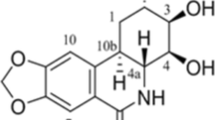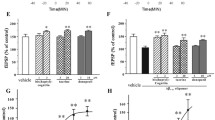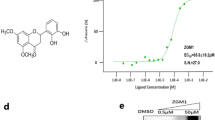Abstract
Fibrillar aggregates of β-amyloid protein (Aβ) is the main constituent of senile plaques and considered to be one of the causative events in the pathogenesis of Alzheimer’s disease (AD). Compounds that could inhibit the formation of Aβ fibrils and block Aβ fibrils-associated toxicity may have therapeutic potential to combat AD. Bis(12)-hupyridone (B12H) is a multifunctional homodimer derived from huperzine A, which is an anti-AD drug in China. In the current study, the inhibitory effect of B12H on the formation of Aβ fibrils and their associated toxicity was investigated both in vitro and in vivo. By using Thioflavin T fluorescence assay, we found that B12H (0.3–3 μM) directly inhibited Aβ fibrils formation following co-incubation of B12H and Aβ1–40 at 37 °C for 6 days in vitro. However, huperzine A, at the same concentrations, did not show significant inhibitory effect on Aβ1–40 fibrils formation. Moreover, B12H markedly reduced Aβ1–40-induced cytotoxicity in cultured SH-SY5Y cells, as evidenced by the increase in cell viability, the decrease in lactate dehydrogenase release, and the reduction of apoptotic nuclei. Most importantly, B12H (0.2 and 0.4 mg/kg) reduced intracerebroventricular Aβ1–40 infusion-induced cognitive and memory impairments in rats, as evidenced by the decrease in escape latency and the increase in the spatial bias in Morris water maze test along with increasing choline acetyltransferase activity and decreasing acetylcholinesterase activity. Collectively, our study provided novel sights into the potential application of B12H in AD treatment.





Similar content being viewed by others
Abbreviations
- Aβ:
-
β-Amyloid protein; acetylcholinesterase
- AD:
-
Alzheimer’s disease
- ANOVA:
-
Analysis of variance
- ChAT:
-
Choline acetyltransferase
- DMEM:
-
Dulbecco’s modified Eagle’s medium
- DMSO:
-
Dimethyl sulfoxide
- FBS:
-
Fetal bovine serum
- HFIP:
-
1,1,1,3,3,3,-Hexafluoro-2-propanal
- LDH:
-
Lactate dehydrogenase
- MTT:
-
3-(4,5-Dimethylthiazol-2-yl)-2,5-diphenyltetrazolium
- MWM:
-
Morris water maze
- NMDA:
-
N-methyl-d-aspartate
- ThT:
-
Thioflavin T
References
Bucciantini M, Nosi D, Forzan M et al (2012) Toxic effects of amyloid fibrils on cell membranes: the importance of ganglioside GM1. FASEB J 26:818–831
Carlier PR, Du DM, Han YF et al (2000) Dimerization of an inactive fragment of huperzine A produces a drug with twice the potency of the natural product. Angew Chem Int Ed Engl 39:1775–1777
Chen G, Chen KS, Knox J et al (2000) A learning deficit related to age and beta-amyloid plaques in a mouse model of Alzheimer’s disease. Nature 408:975–979
Cui W, Hu S, Chan HH, Luo J et al (2012) Bis(12)-hupyridone, a novel acetylcholinesterase inhibitor, protects against glutamate-induced neuronal excitotoxicity via activating alpha7 nicotinic acetylcholine receptor/phosphoinositide 3-kinase/Akt cascade. Chem Biol Interact 203:365–370
Goldsworthy MR, Vallence AM (2013) The role of beta-amyloid in Alzheimer’s disease-related neurodegeneration. J Neurosci 33:12910–12911
Hampel H (2013) Amyloid-beta and cognition in aging and Alzheimer’s disease: molecular and neurophysiological mechanisms. J Alzheimers Dis 33(Suppl 1):S79–S86
Hardy J, Selkoe DJ (2002) The amyloid hypothesis of Alzheimer’s disease: progress and problems on the road to therapeutics. Science 297:353–356
Hu S, Cui W, Mak S et al (2013a) Bis(propyl)-cognitin protects against glutamate-induced neuro-excitotoxicity via concurrent regulation of NO, MAPK/ERK and PI3-K/Akt/GSK3beta pathways. Neurochem Int 62:468–477
Hu SQ, Cui W, Xu DP et al (2013b) Substantial neuroprotection against K deprivation-induced apoptosis in primary cerebellar granule neurons by novel dimer bis(propyl)-cognitin via the activation of VEGFR-2 signaling pathway. CNS Neurosci Ther 19:764–772
Kirkitadze MD, Kowalska A (2005) Molecular mechanisms initiating amyloid beta-fibril formation in Alzheimer’s disease. Acta Biochim Pol 52:417–423
Kroth H, Ansaloni A, Varisco Y et al (2012) Discovery and structure activity relationship of small molecule inhibitors of toxic beta-amyloid-42 fibril formation. J Biol Chem 287:34786–34800
Li WM, Kan KK, Carlier PR, Pang YP, Han YF (2007) East meets West in the search for Alzheimer’s therapeutics—novel dimeric inhibitors from tacrine and huperzine A. Curr Alzheimer Res 4:386–396
Ono K, Hasegawa K, Naiki H, Yamada M (2004) Curcumin has potent anti-amyloidogenic effects for Alzheimer’s beta-amyloid fibrils in vitro. J Neurosci Res 75:742–750
Rambaran RN, Serpell LC (2008) Amyloid fibrils: abnormal protein assembly. Prion 2:112–117
Schenk D, Basi GS, Pangalos MN (2012) Treatment strategies targeting amyloid beta-protein. Cold Spring Harb Perspect Med 2:a006387
Wang R, Zhang HY, Tang XC (2001) Huperzine A attenuates cognitive dysfunction and neuronal degeneration caused by beta-amyloid protein-(1–40) in rat. Eur J Pharmacol 421:149–156
Wang BS, Wang H, Wei ZH, Song YY, Zhang L, Chen HZ (2009) Efficacy and safety of natural acetylcholinesterase inhibitor huperzine A in the treatment of Alzheimer’s disease: an updated meta-analysis. J Neural Transm 116:457–465
Yang F, Lim GP, Begum AN et al (2005) Curcumin inhibits formation of amyloid beta oligomers and fibrils, binds plaques, and reduces amyloid in vivo. J Biol Chem 280:5892–5901
Yu H, Li WM, Kan KK et al (2008) The physicochemical properties and the in vivo AChE inhibition of two potential anti-Alzheimer agents, bis(12)-hupyridone and bis(7)-tacrine. J Pharm Biomed Anal 46:75–81
Zhang JM, Hu GY (2001) Huperzine A, a nootropic alkaloid, inhibits N-methyl-d-aspartate-induced current in rat dissociated hippocampal neurons. Neuroscience 105:663–669
Zhang HY, Tang XC (2006) Neuroprotective effects of huperzine A: new therapeutic targets for neurodegenerative disease. Trends Pharmacol Sci 27:619–625
Acknowledgments
This work was supported by grants from the Research Grants Council of Hong Kong (PolyU5610/11M, 15101014), The Hong Kong Polytechnic University (G-U952, G-YM32, and G-YZ15), Ningbo International Science and Technology Cooperation Project (No. 2014D10019), and the National Natural Science Foundation of China (81202510).
Author information
Authors and Affiliations
Corresponding author
Rights and permissions
About this article
Cite this article
Hu, S., Wang, R., Cui, W. et al. Inhibiting β-Amyloid-Associated Alzheimer’s Pathogenesis In Vitro and In Vivo by a Multifunctional Dimeric Bis(12)-hupyridone Derived from Its Natural Analogue. J Mol Neurosci 55, 1014–1021 (2015). https://doi.org/10.1007/s12031-014-0458-5
Received:
Accepted:
Published:
Issue Date:
DOI: https://doi.org/10.1007/s12031-014-0458-5




